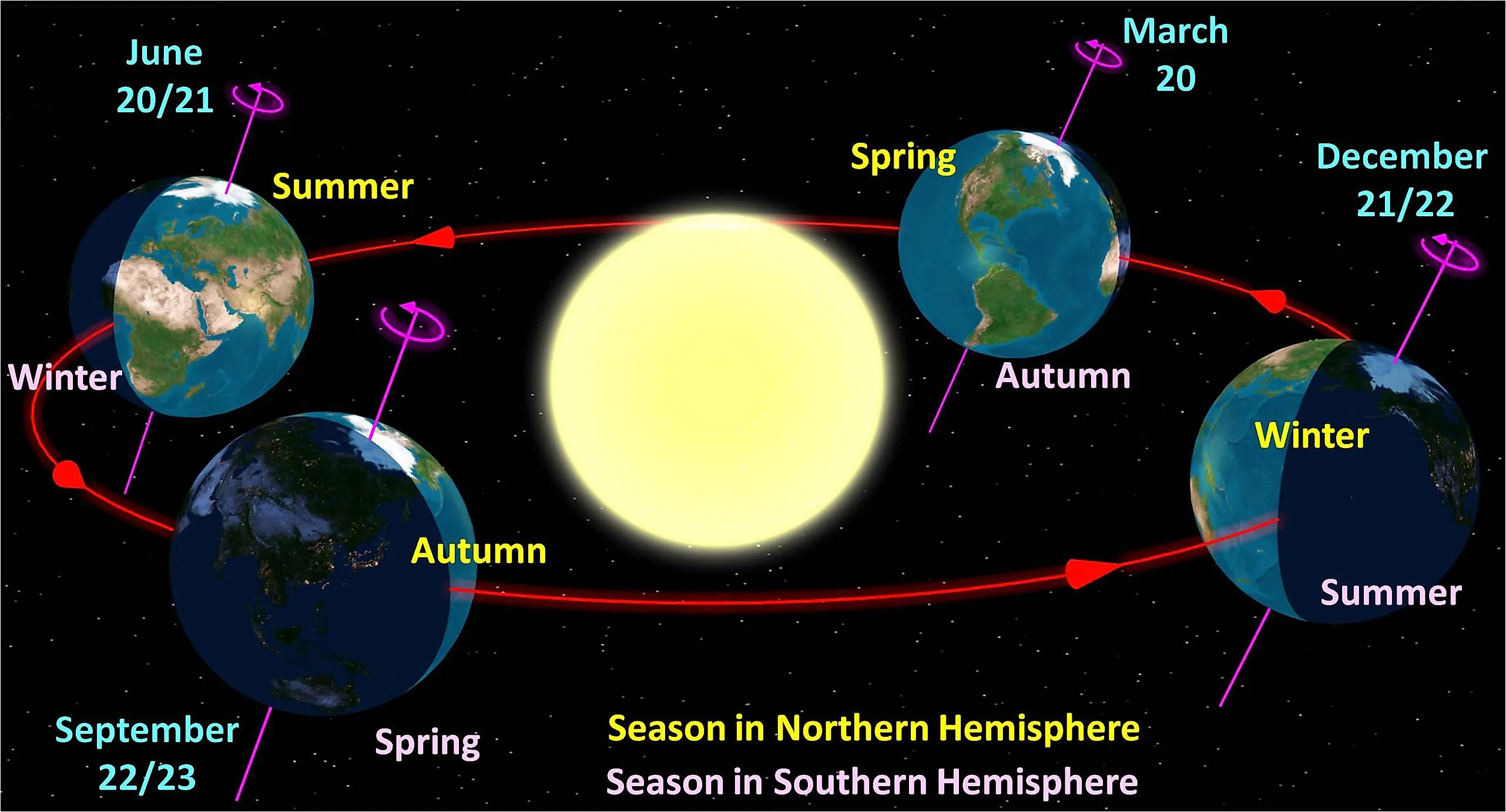
When Is The Longest Day Of The Year?
The "longest day" is a geometric milestone rather than a quirk of the calendar. It falls at the summer solstice, the instant when the Sun's apparent centre reaches its maximum northern (or southern) latitude on the celestial sphere. For 2025, this moment occurs on 21 June 2025 at 02:42 UTC (03:42 BST), marking midsummer north of the equator and mid-winter to the south.
Orbital Mechanics behind the Solstice
Earth's axis is tilted 23.44° from the plane of its orbit around the Sun, a property called obliquity. Because the orientation of that tilt remains nearly fixed in space while Earth revolves, the hemisphere leaning most toward the Sun in June receives sunlight at the steepest noon angle; six months later, the situation is reversed. Obliquity is not static: NASA measurements show it slowly oscillates between about 22.1° and 24.5° over 41,000 years, modulating the strength of the seasons.
Day-Length Geometry
At the June solstice, the Sun sits directly above the Tropic of Cancer (23° 26' N). From that latitude, the farther north you travel, the longer the arc the Sun traces across the sky and the more daylight you receive. The equator still enjoys roughly twelve hours of sunlight, but by 40° N, Madrid, New York, and Beijing, sunrise-to-sunset stretches past fifteen hours. Cross the Arctic Circle (66° 34' N) and the Sun never dips below the horizon, creating the celebrated "midnight sun." In 2025, London (51° 30' N) records 16 h 38 m of daylight on 21 June, while Reykjavík basks in a shade over 20 h.
Earliest Sunrise, Latest Sunset
The solstice is not the date of the earliest dawn or latest dusk. Because Earth's orbit is slightly elliptical and its axial spin is not synchronized with its orbital motion, the equation of time causes solar noon to drift. In London, the earliest sunrise precedes the solstice by roughly four days (17 June 2025), whereas the latest sunset lags by three to four days (24 June). timeanddate.com Atmospheric refraction lengthens daylight further, adding about 4 minutes at temperate latitudes because we see the Sun when its centre is geometrically ~0.83° below the horizon.
The December Counterpart
While the Northern Hemisphere basks in maximal daylight, the December solstice (21 December 2025 at 15:03 UTC) brings the year's shortest day there and the longest day south of the equator. Energy imbalance between hemispheres is cancelled over an annual cycle; averaged globally, the planet always accumulates 12 hours of daylight per 24-hour mean solar day. timeanddate.com
Seasonal (Thermal) Lag
Despite the June peak in insolation, statistical temperature maxima in mid-latitudes occur weeks later. This seasonal lag arises because land, oceans, and atmosphere possess thermal inertia: they continue absorbing net solar energy after the solstice until radiative and convective losses catch up, hence July is climatologically the warmest month for much of the United States and Europe. washingtonpost.com
Long-Term Variations and Milanković Cycles
Axial precession (a 25,800-year wobble) gradually shifts the solstice point westward along Earth's orbit, altering the date of the longest day by about 20 minutes per century. Coupled with the 41,000-year obliquity cycle and a 100,000-year eccentricity cycle, this motion modulates latitudinal insolation and is a cornerstone of Milanković's astronomical theory of ice ages. science.nasa.gov
Beyond Earth: Comparative Planetology
Obliquity controls seasonality on other planets as well. Mars, with a tilt of 25.2°, exhibits solstice snow-cap retreat and dust-storm growth, while Uranus, its axis lying almost in the orbital plane (98° tilt), undergoes extreme solstices lasting 21 years of continual sunlight or darkness at the poles. Comparative studies underscore how axial tilt, rather than orbital distance alone, dictates seasonal contrast. nssdc.gsfc.nasa.gov
Cultural and Scientific Significance
Empirical awareness of the longest day predates written history; Neolithic monuments such as Stonehenge align with the solstitial sunrise, reflecting the practical need to calibrate agricultural calendars. In modern geodesy, the solstice defines one of the four cardinal points used to specify Earth's orbital longitude, anchoring coordinate systems employed in spacecraft navigation. Meteorologists likewise use solstice dates to partition climatological "seasons," while solar-power engineers design panel tilt angles from declination tables referenced to these extrema.
The longest day of the year is more than a folkloric waypoint; it is a predictable result of axial geometry, orbital dynamics and atmospheric optics. Precise ephemerides tell us that in 2025, the Sun's centre will reach its maximum northern excursion at 02:42 UTC on 21 June, giving mid-latitude observers upwards of sixteen hours of daylight. Though the excess sunlight boosts energy receipt immediately, climatic and ecological responses unfold on timescales from weeks (surface warming) to millennia (ice-sheet cycles) as Earth's slowly varying tilt and orbital shape remodel insolation patterns. Thus, the summer solstice provides a natural laboratory for disciplines ranging from astronomy and climatology to anthropology, all drawn together by the simple question: How long is the day?











